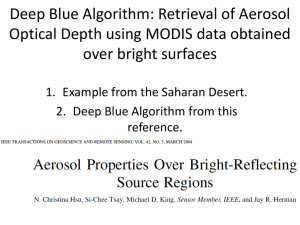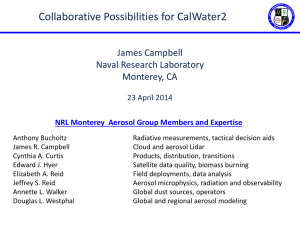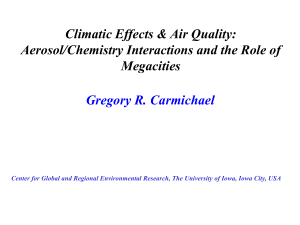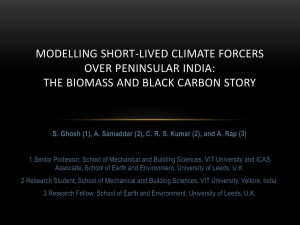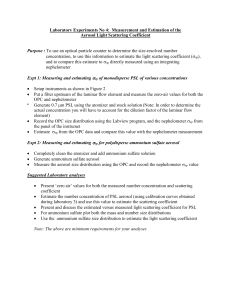AMS Abstrakt
advertisement
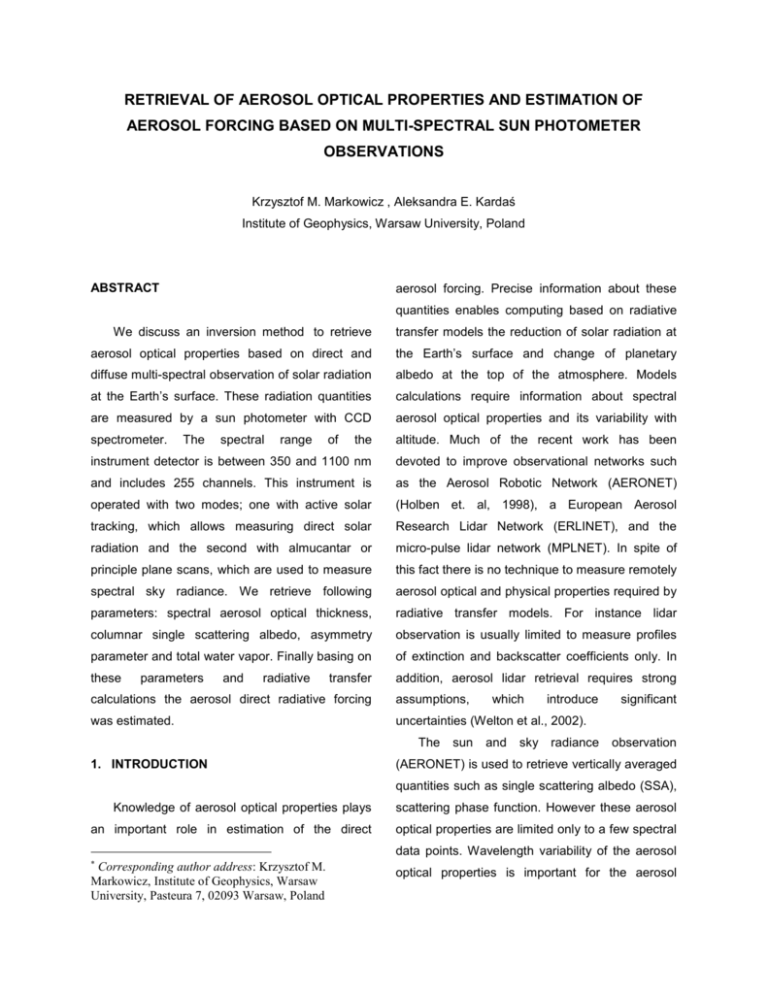
RETRIEVAL OF AEROSOL OPTICAL PROPERTIES AND ESTIMATION OF AEROSOL FORCING BASED ON MULTI-SPECTRAL SUN PHOTOMETER OBSERVATIONS Krzysztof M. Markowicz , Aleksandra E. Kardaś Institute of Geophysics, Warsaw University, Poland ABSTRACT aerosol forcing. Precise information about these quantities enables computing based on radiative We discuss an inversion method *to retrieve transfer models the reduction of solar radiation at aerosol optical properties based on direct and the Earth’s surface and change of planetary diffuse multi-spectral observation of solar radiation albedo at the top of the atmosphere. Models at the Earth’s surface. These radiation quantities calculations require information about spectral are measured by a sun photometer with CCD aerosol optical properties and its variability with spectrometer. the altitude. Much of the recent work has been instrument detector is between 350 and 1100 nm devoted to improve observational networks such and includes 255 channels. This instrument is as the Aerosol Robotic Network (AERONET) operated with two modes; one with active solar (Holben et. al, 1998), a European Aerosol tracking, which allows measuring direct solar Research Lidar Network (ERLINET), and the radiation and the second with almucantar or micro-pulse lidar network (MPLNET). In spite of principle plane scans, which are used to measure this fact there is no technique to measure remotely spectral sky radiance. We retrieve following aerosol optical and physical properties required by parameters: spectral aerosol optical thickness, radiative transfer models. For instance lidar columnar single scattering albedo, asymmetry observation is usually limited to measure profiles parameter and total water vapor. Finally basing on of extinction and backscatter coefficients only. In these addition, aerosol lidar retrieval requires strong The parameters spectral and range radiative of transfer calculations the aerosol direct radiative forcing assumptions, was estimated. uncertainties (Welton et al., 2002). The 1. INTRODUCTION sun which and introduce sky radiance significant observation (AERONET) is used to retrieve vertically averaged quantities such as single scattering albedo (SSA), Knowledge of aerosol optical properties plays scattering phase function. However these aerosol an important role in estimation of the direct optical properties are limited only to a few spectral data points. Wavelength variability of the aerosol * Corresponding author address: Krzysztof M. Markowicz, Institute of Geophysics, Warsaw University, Pasteura 7, 02093 Warsaw, Poland optical properties is important for the aerosol radiative forcing but also for the identification of to aerosol type. measurement. In this paper we discuss new observational block two channels and perform dark Both tubes limiting the FOVs were mounted technique to measure and retrieve multi-spectral on two-axis sun tracker. This tracker allows to aerosol optical properties. We present results follow up the sun with precision about 0.01 o and it obtained during SAWA experiment, which took performs sky scans (almucantar, principle or place in Warsaw, Poland in 2005. others). The MSSP instrument is controlled by MatLab software by USB2 and RS232 ports. 2. AUTOMATIC SUN AND SKY SCANNING The MSSP is calibrated according to the MULTI-SPECTRAL SUN PHOTOMETER Langley method. We are using this technique for the SUN channel. For the SKY channel the In this section we describe Multi-Spectral Sun Langley method cannot be applied because direct Photometer (MSSP), which is used to measure solar radiation saturates the MMS1 spectrometer. spectral: direct and diffuse solar radiance. The In order to calibrate SKY channel we compare it main with the SUN one in the region of sun aureole. part of this instrument is a CCD spectrometer with 256 channels. We use the MMS1 UV-VIS Zeiss spectrometer with the 3. RETRIEVAL OF SPECTRAL AEROSOL spectral range between 320 and 1100 nm. OPTICAL PROPERTIES Resolution of this detector is about 3 nm and wavelength accuracy is about 0.2 nm. The The AOT measurements have been made for measurement time (integration time) can be many years with two general techniques. One adjusted from 1.5 to 6500 ms. Noise of this approach uses a narrow field of view radiometer detector is small and does not exceed 3 digital pointed directly at the sun (Volz, 1959) and the number (DN). Although, the dynamic range of the second one uses a shadow band radiometer that MMS1 spectrometer is determined by 15 Bit A/D measures the total and diffuse solar radiations. converter (33 768 DN) it is too small to measure The MSSP instrument uses the first approach, direct solar and sky radiance. Therefore we where the AOT is calculated from Beer-Lambert measure these radiance components with different law. For this purpose we use observation of the field of view (FOV). The direct solar radiance is direct solar radiance. For significant part of 2o detector pixels simple Beer-Lambert relationship FOV. To reduce the direct solar radiance (in the cannot be applied because of oxygen, ozone, and case of the smallest FOV) we use 10% of water vapor absorption bands. Correction for transmission gray filter. In addition the integration these measured by 1o FOV and sky radiance with time for sky radiance is about 103 gasses requires radiative transfer larger if calculations of the spectral transmittance as a compared to direct solar radiance. We use two function of solar zenith angle and total amount of fiber shutters to block one channel (sun or sky) or gases in the vertical column. Based on the differential absorption technique negligible. the total water vapor is estimated. For this purpose we use the water vapor absorption band at 936 nm and radiative transfer model. We use MODTRAN, ver. 4.1, which was run in the transmittance mode with 20 cm -1 spectral resolutions. Retrieval of the SSA and scattering phase function or the asymmetry parameter is more complicated. Distribution of downward diffuse sky radiance for almucantar scan can be described by I(, ) Fo e mo m o [P() MS(...)] (1) where, is scattering angle, m o is the air mass factor, total optical thickness, Fo is the direct flux at the top of the atmosphere, and MS(…) term describes multiple scattering. Thus ratio of diffuse to direct solar radiance is a function of aerosol and molecular optical properties R (, ) I(, ) m o [P() MS(...)] . Fdir () (2) Fig.1 Calculated sky radiance ratio for different aerosol optical properties based on single scattering approximation (opened points) and DISORT included multi-scattering (dotted points). Blue pointes correspond to the sky radiance ratio for two aerosol optical models. Both models have the same asymmetry parameter (0.75) but different value of the SSA (1.0 for the first model and 0.9 for second). Similar for red points but in this case the SSA is constant and set to value 0.9 and the asymmetry parameter is equal 0.6 for the first model and 0.7 for second model. In the case of the single scattering approximation angular variability of the diffuse to direct ratio R(,) is only function of the scattering phase radiance we use the same radiative transfer model. Modtran uses DISORT solver, which function. Fig. 1 shows calculated sky radiance ratio for different aerosol optical properties as a function of the scattering angle (for almucantar scan). Sky radiance changes significantly larger due to variability of the asymmetry parameter (red lines) than for the SSA (blue lines). Note the model calculation was performed for the AOT of 0.2 and for this value difference between the single scattering In order to calculate the distribution of sky approximation (open circles) and multiple scattering model (dotted squares) is not enables multi-scattering calculation up to 16 radiance streams. As the input data we use standard atmospheric profiles, however we scale the input profiles: the total water vapor and total ozone according to the observation. MODTRAN requires information about spectral aerosol optical properties such as coefficient, the SSA the and aerosol the extinction asymmetry parameter. These spectral aerosol quantities are constant with altitude (MODTRAN allows to set four different aerosol models). However, profiles of the aerosol extinction coefficient at 550 nm can by applied independently. In this study we assume exponential decreasing of the aerosol extinction springtime. Therefore, we decided to carry out this coefficient with the altitude. The assumption for experiment between end of March and May. typical profile, for most of the atmospheric To the objectives we estimated the AOT of conditions does not influence critically the retrieval spherical and nonspherical particles using 3 quantities (Dubovik et al., 2000). wavelengths lidar, MSSP, MICROTOPS, and Multi In this paper we assumed values of spectral Filter Rotating Shadow Band Radiometer. The surface albedo concerning the surface type. contribution of the nonspherical AOT to the total Because surface albedo has significant influence AOT was determined from analysis of lidar on the multiple scattering (especially over the depolarization at 532 nm. The comparison of the surface with large albedo) in the future we will observed radiative fluxes during the days with and attempt to measure spectral albedo by the MSSP without Saharan dust events gives an evidence of instrument. the aerosol forcing caused by nonspherical Based on the MODTRAN we developed large aerosol. 5D look-up table. This table includes following The mean reduction (during SAWA) of the independent variables: AOT, SSA, asymmetry solar radiation at the surface due to aerosol is parameter, solar zenith angle and relative azimuth about 6% and the mean aerosol forcing is about angle. By minimizing the difference between -18 Wm-2. The aerosol forcing efficiency was modeled and observed sky almucantar radiances estimated between -70 and -77 Wm-2 and these at each wavelength we retrieve the SSA and the values are characteristic for the moderately asymmetry parameter. absorbing aerosol. The change of aerosol forcing The aerosol radiative forcing is estimated from the aerosol optical properties due to nonspherical particles is small however the and radiative difference of radiative forcing between spherical transfer calculation of total downward and upward and nonspherical particles strongly depends on fluxes. For this purpose the aerosol optical the aerosol size and the aerosol shape. The quantities are spectrally extended up to 4 m. The results of this study are discussed by Markowicz Angstrom relationship for the AOT and the SSA is et al. (2005). assumed. Fig. 2 presents spectral variability of the AOT (Fig. 2a) and the SSA (Fig. 2b) obtained using the 4. RESULTS AND CONCLUSION MSSP observation as described above in section 3. Different slope of the AOT in the visible range In this section we present the results obtained indicates different particles effective size. The during SAWA experiment, which took place in mean (defined for the entire measured spectrum) Warsaw, Poland in April and in May 2005. The Angstrom exponent in April 20 is 1.17 while in May main goal of this campaign was to estimate the 20 is 0.78. The wavelength variability of the SSA aerosol forcing of the nonspherical Saharan dust. for these two days is similar, but values of the Saharan dust over Central Part of Europe can be SSA are significantly different. observed several times a year, especially during This method makes possible analysis of the Holben, B. N., T. F. Eck, I. Slutsker, D. spectral variability of the aerosol optical properties Tanr&eacute, J. P. Buis, A. Setzer, E. F. Vermote, which are function of the particles size distribution, J. A. Reagan, Y. J. Kaufman, T. Nakajima, F. shape, and refractive index. Thus our retrieved Lavenu, parameters may be used in inversion methods in AERONET – A federated instrument network and order to estimate the aerosol size distribution. data archive for aerosol characterization. Remote Uncertainties of the retrieval of the SSA and I. Jankowiak, A. Smirnov, 1998: Sensing of Environment, 66(1), 1-16. the scattering phase function or the asymmetry parameters are reduced due to observational Markowicz, K. M, A.E. Kardas, C. Hochherz, K. technique. Estimation of these quantities requires Stelmaszczyk, A.Rozwadowska, T. Zielinski, G. only relative calibration between SUN and SKY Karasinski, channels. Absolute calibration is needed only for Malinowski, T. Stacewicz, L. Woeste, 2005: the AOT retrieval. However, the AOT includes Observation of optical properties and radiative usually smaller errors than others optical forcing of nonspherical particles over Poland, properties due to simpler methodology. Accent symposium, Sep 2005 – Aerosol: air J. Remiszewska, M. Witek, S. quality and climate. Welton, E. J., J. R. Campbell, 2002: Micro-pulse Lidar Signals: Uncertainty Analysis, J. Atmos. Oceanic Technol., 19, 2089-2094. Volz, F. E., photoement 1959: Photometer zurspektralen mit Selen- Messung der Sonnenstrahlung und zer Bestimmung der Wallenlangenabhangigkeit der Dunsttrubung (in German). Arch. Me-teor. Geophys. Bioklimatol., Fig. 2 Spectral variability of the AOT (a) and the SSA (b) retrieved from observation performed in April 20 and May 20, 2005. B10, 100–131. 6. ACKNOWLEDGMENTS 5. BIBLIOGRAPHY This research was supported by Grant Dubovik, O., M. D. King, 2000: A flexible 2P04D06927 of Polish Committee for Scientific inversion algorithm for retrieval of aerosol optical Research. We would like to thank the Foundation properties radiance for Polish Science for the support. Conference measurements, J. Geophys. Res., 105, D16, presentation is supported by EVK2-CT2002- 20673-20,696. 80010-CESSAR EC V-th Framework Program from Sun and sky project.

